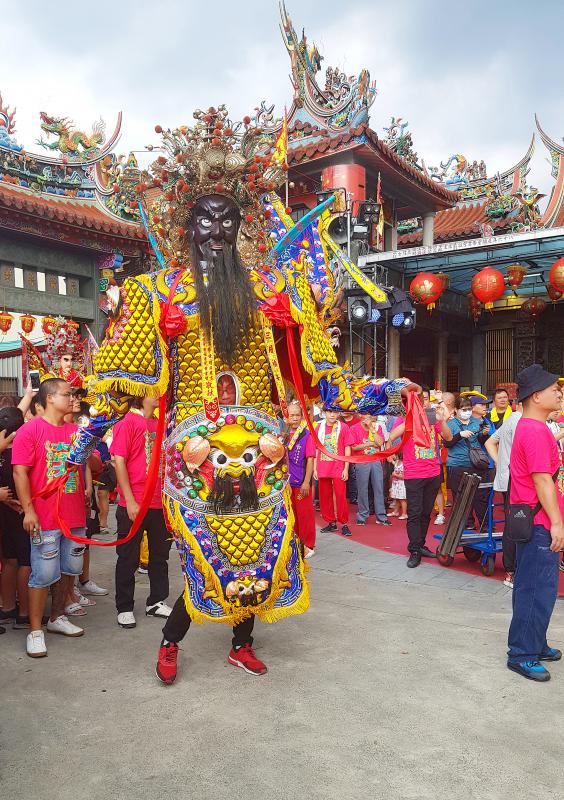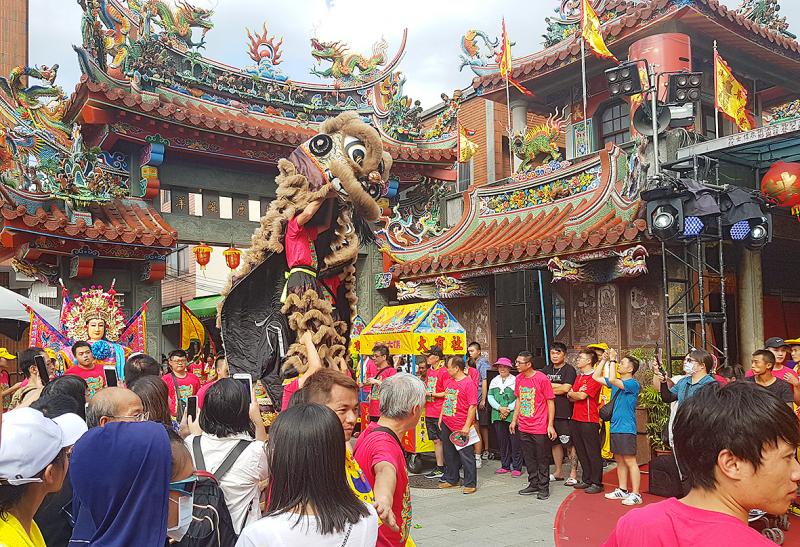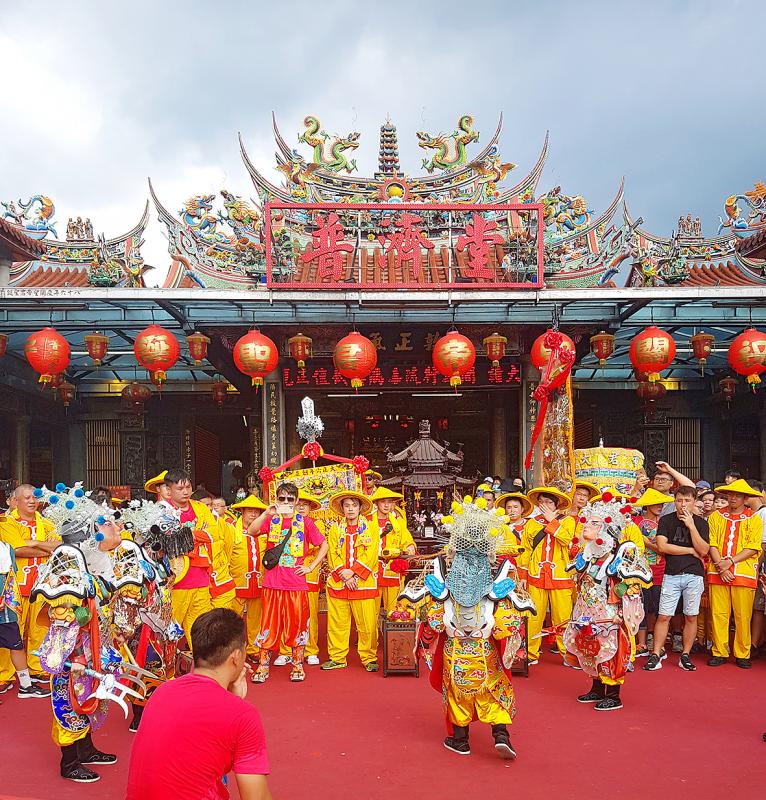Architect Tammy Liu (劉真蓉) recalls being stumped when studying in the Netherlands a teacher asked her to describe Taiwanese culture. No matter how much she pondered, nothing came to mind.
“Our education system doesn’t teach us about Taiwanese culture — at least when I was in school,” Liu, 40, tells the Taipei Times.
And that culture for Liu is small town Taiwan, with its temple festivals and performance troupes and old streets (老街), with all manner of delicacies and handicrafts.

Photo: Noah Buchan, Taipei Times
Liu’s experience overseas is common for Taiwanese. Raised in an education system that downplays the nation’s vast and fascinating folk culture or views its association with society’s shadier elements as an embarrassment, the idea that it could in part define Taiwanese identity was avoided.
No longer. Today the president appears at Jenn Lann Temple’s Mazu Pilgrimage or the culture minister shows up to the opening of a new building at Tainan’s Nankunshen, because they know that doing so attracts votes at election time and brings in tourist dollars. But greater acceptance among the mandarin class has come at the expense of authenticity.
UPDATING TRADITION

Photo: Noah Buchan, Taipei Times
Daxidaxi (大溪大禧) manages to avoid these pitfalls. The two-week cultural festival, which is curated by Liu and supported by the Dasi Wood Art Ecomuseum (桃園市立大溪木藝生態博物館), is taking place in and around Puji Temple (普濟堂) in Taoyuan’s Dasi Township (大溪) until tomorrow.
In addition to parading Guan Gong (關公), the temple’s patron deity and the Chinese god of war and martial arts, around Dasi today and tomorrow, the festival has included music performances that combine temple tunes with rap, exhibitions of photos of temple volunteers and local artisans, as well as an installation on how to make a vow to the god.
The festival taps into the emerging interest in old-time Taiwan by updating some traditions so as to attract a broader audience, while retaining the traditional elements that make Taiwan’s local culture unique.

Photo: Noah Buchan, Taipei Times
Though originally from Taichung’s Fengyuan District (豐原) and only having visited Dasi a couple of times before starting Daxidaxi three years ago, Liu says that there is a vibe that unites all Taiwanese towns: a central temple surrounded by a commercial district — what Liu calls a “dream hometown” because it has preserved much of its traditional architecture and traditional folk and craft culture.
“The style reminds me of my hometown,” Liu, whose previous curatorial foray includes the first Nuit Blanche in Taipei, says motioning towards Puji Temple.
The first Daxidaxi began in 2017, after a local museum commissioned Liu to re-design elements of its parade — from the towels emblazoned with Guan Gong and the talismans that are handed out to worshippers, to the flags that pilgrims carry while on the two-day parade.

Photo courtesy of Daxidaxi
Design leader Liao Hsiao-tzu (real name Liao Chun-yu, 廖俊裕) says that creating designs that would appeal to locals, while breathing new life into a somewhat staid form, required months of research.
“The image of deities will evolve with every generation,” he says. “The purpose is to design in such a way that the local people look at the results and say to themselves: yes, this is ours, this is us.”
Liao says that designers typically impose their own aesthetic ideas on a project — often influenced by Japanese or American aesthetics.

Photo courtesy of DaxiDax
“The aesthetic that people have who grew up around temples is different than professional designers,” he says, motioning towards the elaborate and intricate and colorful designs of the temples. “I wanted something that clearly reflects the local culture.”
And that means incorporating into his designs the colors commonly seen on the intricate temple sculptures and architecture.
If Liao's design aesthetics are based on temple colors and shapes, Liu takes inspiration from Japan for the opening day of the festival, which she calls “parade warming.”
“This is a warming up to make people aware of the parade’s existence,” she says. “So for these two weeks we can show everybody the traditional lifestyle of Dasi and the traditional lifestyle of Taiwan.”
Much of these are on display on the third floor of an exhibition space near the temple. Liu shows me life-sized photos of people from the community, including volunteers at the temple, a local craftsmen and a Eight Generals (八家將) troupe member.
Before heading up to the third floor, I visit an installation on the second floor and pray to Guan Gong.
HARD SELL
Convincing locals to modify the look of the parade and expand its length from a two-day parade to a two-week festival wasn’t an easy sell, Liu says.
In the first year, she visited the temple every second day to speak with locals and canvas their opinions. Additionally, the parade has 32 troupes, each with their own ideas about how traditions should be updated or maintained, and in what order they should appear on the first day of the festival.
“It’s a political issue,” Liu said of the squabbling among the different troupes.
“They also think that I’m an outsider who doesn’t understand [the community],” she says.
Although changes have been made to the parade, they are largely superficial. The flags may not mimic the imperial style of old, or the talismans bear the regal colors of the emperor, but the reality is the parade route and religious folk icons such as the Eight Generals, lion dancers and the Third Prince (santaizi, 三太子) appear in the same traditional costumes.
But changing the look of the original parade was never the purpose, Liu says. Instead, it was to attract those to Dasi who pine for some nostalgia of Taiwan’s past.
“And that’s what a dream hometown is all about.”
■ For more information, visit: www.facebook.com/DaxiCulFes

Many people noticed the flood of pro-China propaganda across a number of venues in recent weeks that looks like a coordinated assault on US Taiwan policy. It does look like an effort intended to influence the US before the meeting between US President Donald Trump and Chinese dictator Xi Jinping (習近平) over the weekend. Jennifer Kavanagh’s piece in the New York Times in September appears to be the opening strike of the current campaign. She followed up last week in the Lowy Interpreter, blaming the US for causing the PRC to escalate in the Philippines and Taiwan, saying that as

US President Donald Trump may have hoped for an impromptu talk with his old friend Kim Jong-un during a recent trip to Asia, but analysts say the increasingly emboldened North Korean despot had few good reasons to join the photo-op. Trump sent repeated overtures to Kim during his barnstorming tour of Asia, saying he was “100 percent” open to a meeting and even bucking decades of US policy by conceding that North Korea was “sort of a nuclear power.” But Pyongyang kept mum on the invitation, instead firing off missiles and sending its foreign minister to Russia and Belarus, with whom it

The Chinese Communist Party (CCP) has a dystopian, radical and dangerous conception of itself. Few are aware of this very fundamental difference between how they view power and how the rest of the world does. Even those of us who have lived in China sometimes fall back into the trap of viewing it through the lens of the power relationships common throughout the rest of the world, instead of understanding the CCP as it conceives of itself. Broadly speaking, the concepts of the people, race, culture, civilization, nation, government and religion are separate, though often overlapping and intertwined. A government

Nov. 3 to Nov. 9 In 1925, 18-year-old Huang Chin-chuan (黃金川) penned the following words: “When will the day of women’s equal rights arrive, so that my talents won’t drift away in the eastern stream?” These were the closing lines to her poem “Female Student” (女學生), which expressed her unwillingness to be confined to traditional female roles and her desire to study and explore the world. Born to a wealthy family on Nov. 5, 1907, Huang was able to study in Japan — a rare privilege for women in her time — and even made a name for herself in the